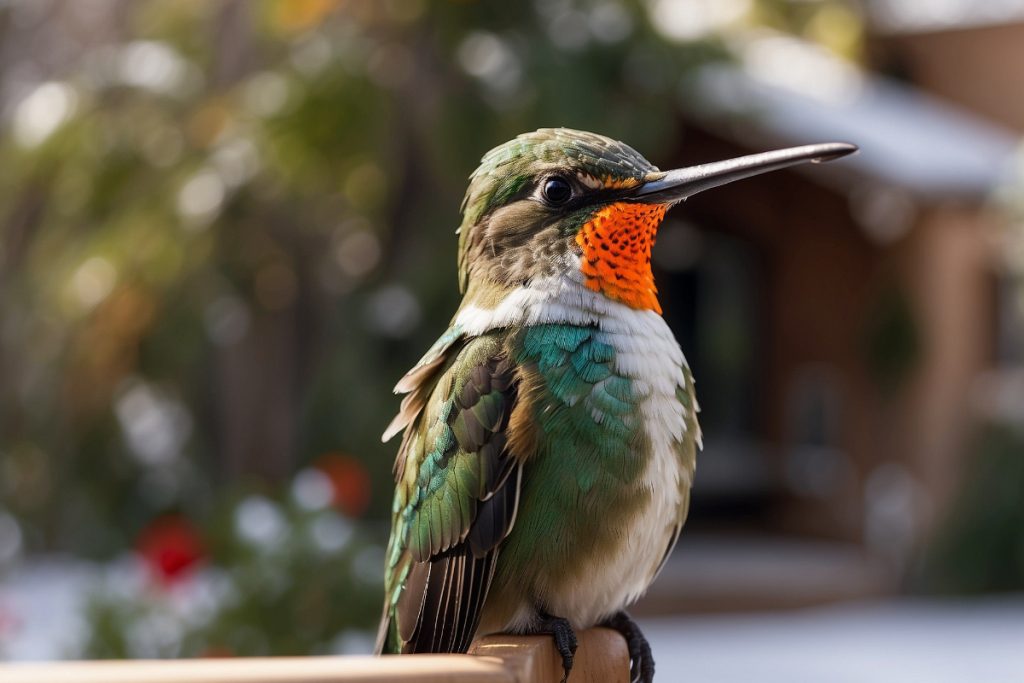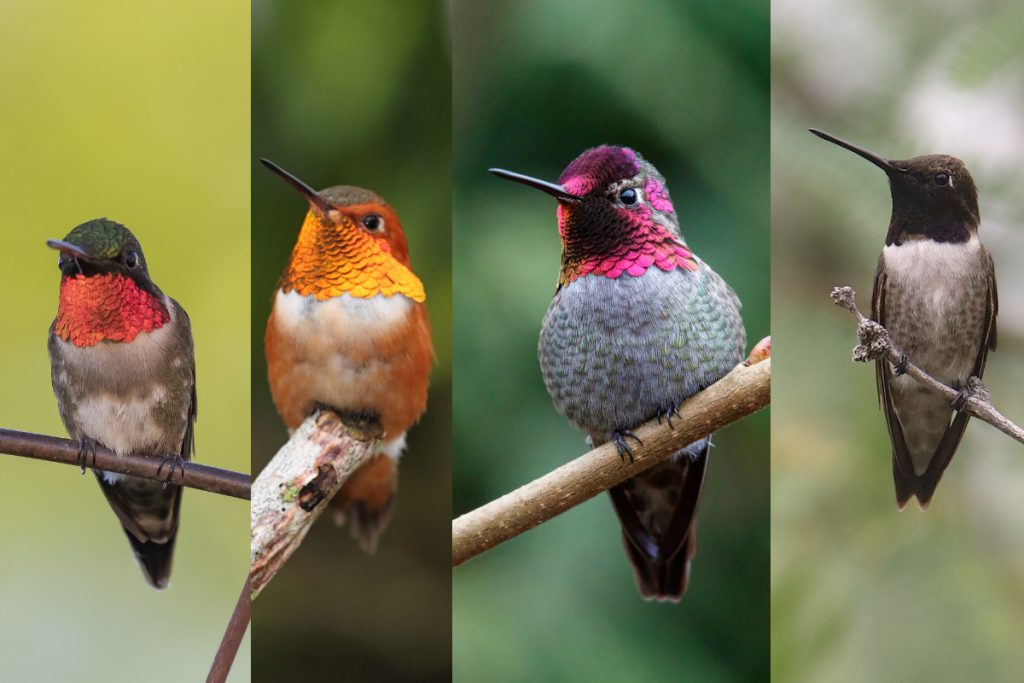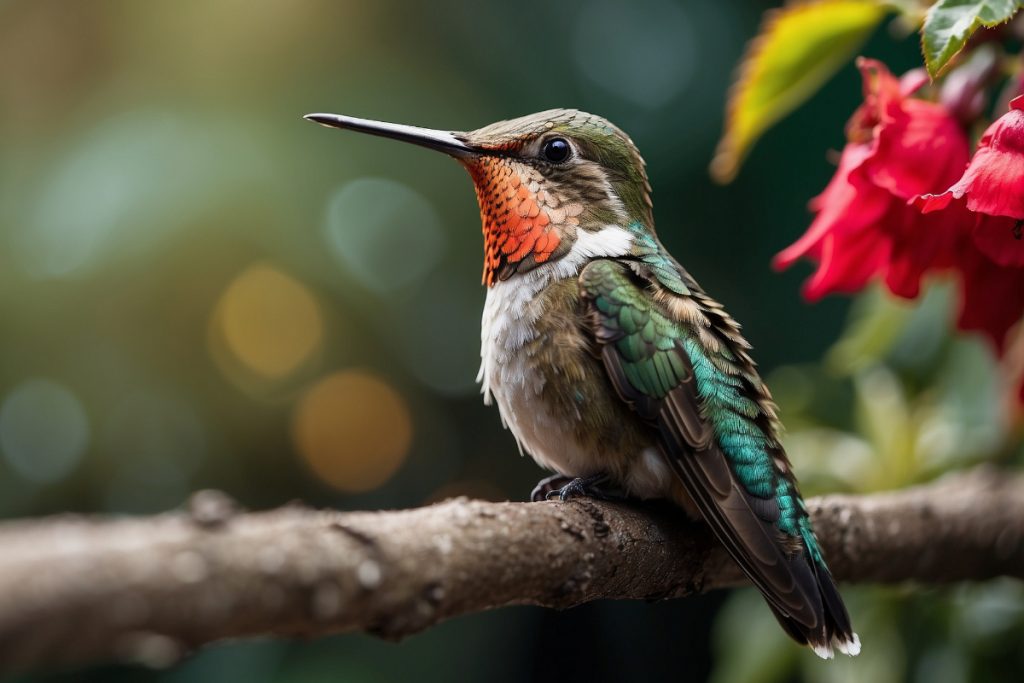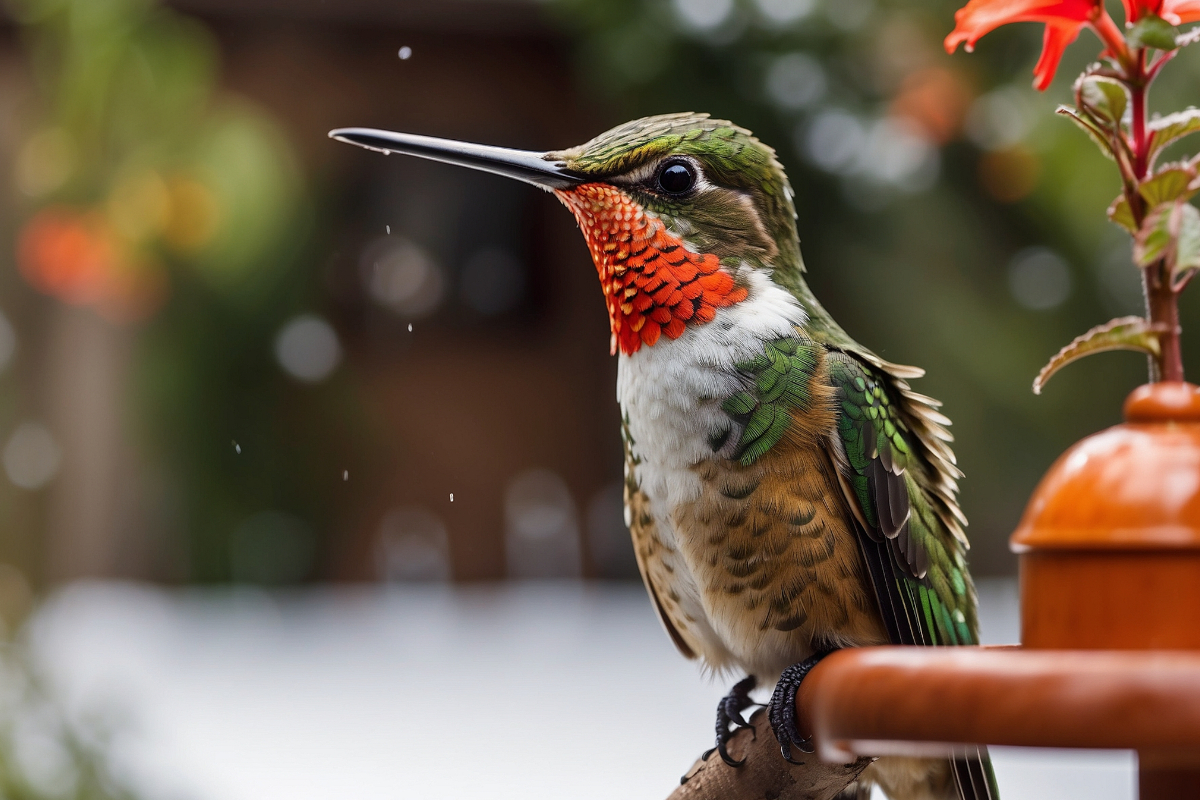Hummingbirds migrate to warmer regions in the winter. They typically travel to Central America, Mexico, and sometimes parts of South America to find food and avoid cold temperatures. This migration ensures they have access to the nectar and insects they need to survive.
To give you a better picture of their winter migration, we will explore in detail where hummingbirds go during the winter months and why they migrate to warmer climates.
We’ll look at the different migration routes of common hummingbird species, the reasons behind their seasonal movements, and how you can support hummingbirds that stay behind or pass through your area during colder months.
Key Takeaways:
- Most hummingbirds migrate south to Mexico, Central America, and northern South America for the winter months when food becomes scarce farther north.
- A few hummingbird species, like Anna’s hummingbirds, may overwinter along the Pacific Coast or in the Desert Southwest, where flowering plants still bloom.
- Hummingbirds migrate to follow food sources and escape colder temperatures. Decreasing daylight triggers their internal migration clock.
- You can help wintering or migrating hummingbirds by keeping feeders clean, filled, and unfrozen. Planting winter-blooming flowers also provides essential food.
Related post to read about Best Hummingbird Feeders

Why Do Hummingbirds Migrate in the Winter?
Hummingbirds migrate for two main reasons – lack of flowering plants and cold temperatures. As days shorten in late summer, blossoms begin to fade, and insect numbers decline across much of North America. This drop in critical food sources triggers a hormonal shift inside hummingbirds that initiates their southerly migrations.
Additionally, these tiny birds would struggle to survive freezing temperatures or snowstorms. So they travel to warmer climates with more plentiful flowers and insects.
Most hummingbirds migrate astonishing distances despite their small size. For example, ruby-throated hummingbirds weighing only a few grams fly nonstop 500 miles across the Gulf of Mexico! They depend on cold fronts, bringing favourable northerly winds to complete this exhausting journey.
By travelling to Central America, Mexico, or the Caribbean, hummingbirds escape harsh winters and gain access to the resources they need to survive.
Species-Specific Migration Patterns
West Coast Migrants
- Anna’s Hummingbird: Some of these birds are year-round residents in the mild climates of California and the Pacific Northwest. Unlike many hummingbirds, Anna’s do not always migrate, taking advantage of the temperate coastal weather.
- Allen’s Hummingbird: Breeding along the coast of California, Allen’s Hummingbirds migrate to central Mexico for the winter.
- Costa’s Hummingbird: Found in the southwestern United States and northwestern Mexico, some Costa’s Hummingbirds are resident while others migrate to southern Mexico during the winter.
Southwest/Mexico Migrants
- Black-chinned Hummingbird: These hummingbirds migrate between the southwestern United States and Mexico, often preferring desert regions and lower elevations during winter.
- Broad-billed Hummingbird: Broad-billed Hummingbirds breed in the southwestern United States and northern Mexico, migrating to central Mexico during the winter months.
- Violet-crowned Hummingbird: Found in the southwestern United States and throughout Mexico, these birds migrate to lower elevations and more southern regions during the winter.
Northern Migrants
- Ruby-throated Hummingbird: Migrating from the eastern United States and southern Canada to Central America, Ruby-throated Hummingbirds often make a non-stop flight across the Gulf of Mexico. Males usually arrive first in the spring and leave first in the fall.
- Rufous Hummingbird: These birds migrate from Alaska and the Pacific Northwest to Mexico. They follow a coastal route southward in the fall and an inland route northward in the spring.
- Calliope Hummingbird: The smallest bird in North America, Calliope Hummingbirds migrate from the northwestern United States and southwestern Canada to Mexico, following the Rocky Mountains.
Mountain Migrants
- Broad-tailed Hummingbird: Breeding in the high mountains of the western United States, Broad-tailed Hummingbirds migrate to southern Mexico and Central America for the winter. These hummingbirds breed at high altitudes in the summer and migrate to lower elevations for the winter.
Gulf Coast Migrants
- Buff-bellied Hummingbird: Found from the Gulf Coast of the United States to the Yucatán Peninsula in Mexico, these hummingbirds migrate short distances within this range depending on the season.
Physiological Adaptations
Hummingbirds prepare for migration by significantly increasing their body weight, primarily through accumulating fat reserves. This stored energy is crucial for sustaining their long flights, especially for those crossing the Gulf of Mexico. During stopovers, their metabolic rate slows down to conserve energy, and they feed intensively on high-energy nectar to quickly replenish their fat reserves.
Migration Triggers
Hummingbirds begin their migration based on a combination of environmental cues, such as changes in daylight length, temperature, and food availability. These triggers ensure they migrate at optimal times to avoid harsh weather and ensure food availability along their routes.
Winter Destinations
Most hummingbirds migrate to Central America, including Mexico, Honduras, and Costa Rica. Some species, like Anna’s Hummingbird, remain year-round in milder climates like California and the Pacific Northwest.
Supporting Migratory Hummingbirds
To support migratory hummingbirds, provide nectar feeders and plant native flowers that bloom during migration periods. Keep feeders clean and filled, especially in early spring and late fall, to support both early migrants and late stragglers. Creating a habitat that offers shelter and protection from predators, such as dense shrubs and trees, is also beneficial.

Common Hummingbird Migration Routes
Different hummingbird species follow distinct migration pathways depending on their breeding and wintering grounds. Let’s look at the migration routes and winter destinations of some widespread North American hummingbirds.
Ruby-throated Hummingbird
Ruby-throats breed across Eastern North America into Canada and then migrate south through Florida or across the Gulf of Mexico to Mexico, Central America, and Panama. Some winters as far south as Costa Rica or Venezuela. Their return trip north begins in February.
Rufous Hummingbird
This species breeds in the Pacific Northwest and Alaska, then migrates through California and the Desert Southwest to winter in Mexico. Some Rufous hummingbirds now overwinter in Gulf Coast states where feeders provide a consistent food source.
Allen’s and Anna’s Hummingbirds
While most Allen’s hummingbirds migrate south through California and Mexico, Anna’s hummingbirds are year-round residents along the Pacific Coast. Some Anna’s also overwinter in areas like Texas and Louisiana, where feeders allow them to persist farther north than otherwise possible. Both species breed in California and the Southwest.
Black-chinned Hummingbird
Black-chinneds breed across the Western United States and then migrate to Mexico for the winter months. As more people put out feeders, a few Black-chinneds attempt to overwinter along the Gulf Coast rather than migrating farther south.
Calliope Hummingbird
This smallest North American hummingbird species breeds inland through the Northwest and Rocky Mountains. They migrate south to winter in Mexico.
As you can see, winter movements vary for each species based on their breeding range and temperature tolerances. Banding studies continue to reveal more details about the migration timing and pathways followed by different hummingbirds.
What Happens to Hummingbirds That Don’t Migrate?
Non-migratory hummingbirds can enter a state of torpor to conserve energy during cold nights. They rely on winter-blooming flowers and feeders to maintain their energy levels, allowing species like Anna’s, Rufous, and Black-chinned Hummingbirds to survive colder winters.

How to Help Hummingbirds in Winter
You can support wintering hummingbirds or migrants passing through your area with a few simple actions:
Leave Feeders Up
Continue filling clean feeders with fresh nectar (1 part sugar to 4 parts water) so any hummingbirds still around or migrating through have a reliable energy source. Take down empty feeders by early March so returning birds aren’t delayed by relying on feeders instead of flowers.
Provide Shelter
Hummingbirds appreciate protected perches out of the wind and cold rain where they can conserve energy. Place feeders under the eaves or porches and provide dense evergreen trees or shrubs for overnight roosting spots.
Plant Winter Flowers
Grow nectar-rich plants that bloom during winter. Good options include coral honeysuckle, red buckeye, pineapple sage, winter jasmine, and camellias. Avoid pesticides, as hummingbirds eat small insects, too.
Report Banded Birds
If you spot a hummingbird with bands on its legs, note the codes and report it via this website. Tracking banded birds provides valuable data on migration timing and survival rates.
With a few small actions, you can make a big difference for hummingbirds overwintering in your area or passing through on their epic migrations between summer breeding and warm wintering grounds.
Final Thoughts
Hummingbirds depend on habitat corridors and food sources during their migrations. While most migrate south to warmer climates in winter, increasing numbers are overwintering farther north due to the availability of feeders and winter-blooming gardens provided by people.
Supporting these birds with nectar, shelter, and reporting banded birds can help them thrive even in colder seasons.

Frequently Asked Questions (FAQs) – Where Do Hummingbirds Go in the Winter?
Q: What triggers the winter migration of North American hummingbirds?
A: North American hummingbirds begin their winter migration in response to decreasing food supplies, particularly nectar from flowering plants and insects. Shorter daylight hours and dropping temperatures also signal the start of their migratory journey.
Q: Where do most hummingbirds go in the winter for warmer climates?
A: Most hummingbirds migrate to warmer climates in southern Mexico and Central America for the winter. This migration helps them access abundant food sources and favourable weather conditions.
Q: Can you name some common species of hummingbirds that migrate?
A: Common migratory hummingbird species include the Ruby-throated Hummingbird, Rufous Hummingbird, Black-chinned Hummingbird, and the Calliope Hummingbird.
Q: What is the winter migration route for Ruby-throated Hummingbirds?
A: Ruby-throated Hummingbirds typically migrate from the eastern half of the United States and Canada, across the Gulf of Mexico, to winter in Central America.
Q: How do Anna’s Hummingbirds adapt to winter in the U.S.?
A: Anna’s Hummingbirds, unlike many other species, are more tolerant of cold weather and often stay along the Pacific Coast all year, including states like California and Washington State. They adapt by finding local food sources and shelter.
Q: What unique challenge do hummingbirds face when crossing the Gulf of Mexico?
A: When crossing the Gulf of Mexico, hummingbirds undertake a non-stop 500-mile flight, which is one of the longest migratory journeys relative to their size. They rely on favourable winds and must build up significant fat reserves to fuel this arduous journey.
Q: How can backyard feeders help hummingbirds in winter?
A: Keeping your feeder filled with a sugar-water mixture (1 part sugar to 4 parts water) can provide a crucial food source for hummingbirds that remain in or pass through colder areas during winter migration.
Q: Do all North American hummingbirds fly south for the winter?
A: Not all North American hummingbirds migrate south. Species like Anna’s Hummingbird may remain in milder climates along the Pacific Coast or try to winter in the Desert Southwest.
Q: What adaptations help hummingbirds survive cold temperatures?
A: Hummingbirds can enter a state of torpor, significantly slowing their metabolism to conserve energy during cold nights. This adaptation is vital for those staying farther north in winter.
Q: How do hummingbird feeders impact the migration patterns of hummingbirds?
A: Hummingbird feeders can influence migration patterns by providing additional food sources, encouraging some species to extend their stay in areas they might otherwise leave. This is particularly true for species like the Rufous and Black-chinned Hummingbirds along the Gulf Coast.
Q: Are there specific types of plants that attract hummingbirds in winter?
A: Yes, planting nectar-rich flowering plants like coral honeysuckle, red buckeye, and camellias can attract and support hummingbirds in winter, especially in milder climates.
A: Hummingbirds rely on a combination of innate instincts, the position of the sun, and Earth’s magnetic field to navigate during their migration between breeding and wintering grounds.
Q: What role does the American Bird Conservancy play in hummingbird conservation?
A: The American Bird Conservancy undertakes various conservation initiatives to protect hummingbirds and their habitats, including promoting bird-friendly gardens and supporting research on migratory patterns.
Q: Can hummingbirds be found in urban areas during winter?
A: Yes, hummingbirds can be found in urban areas during winter, especially where backyard hummingbird feeders and winter-blooming gardens are maintained, providing essential food sources.
Q: What is the significance of banding studies in understanding hummingbird migration?
A: Banding studies are crucial for tracking the migration, breeding, and survival of hummingbirds. They provide valuable data on migratory routes, timing, and how changes in climate and habitat affect hummingbirds.
Q: How do hummingbirds fuel their long migratory journeys?
A: Hummingbirds fuel their migratory journeys by consuming large amounts of nectar and insects. They build up fat reserves, which provide energy for long flights, especially when crossing large bodies of water like the Gulf of Mexico.
Q: What challenges do hummingbirds face in their wintering grounds in Central America?
A: In their wintering grounds in Central America, hummingbirds face challenges such as habitat loss, competition for food sources, and changing climate conditions that can affect the availability of nectar and insects.
Q: How does climate change impact hummingbird migration?
A: Climate change can alter the timing and availability of food sources along migratory routes, potentially disrupting the traditional migration timing and pathways of hummingbirds.
Q: What is the breeding season for North American hummingbirds, and how does it relate to migration?
A: The breeding season for North American hummingbirds typically starts in late spring and lasts through summer. The end of the breeding season is one of the triggers for the start of their migration to wintering grounds.
Q: How can individuals participate in projects like Project FeederWatch to help hummingbirds?
A: Individuals can participate in citizen science projects like Project FeederWatch by counting and reporting hummingbirds and other birds at their feeders, providing valuable data for ornithological research and conservation efforts.
Useful Links:
Related Posts to Read:
- 25 Hummingbird Behaviors.
- Do Hummingbirds Beaks Open When Feeding?
- 6 Fascinating Facts About Hummingbird Sizes.
- Hummingbird Diet and Nutrition.
- How Much Does A Hummingbird Eat Per Day?
- Do Hummingbirds Eat Bees?
- Do Hummingbirds Eat Wasps?
References:
- About Hummingbird (Link).
- Greenewalt, C. H. (1960). Hummingbirds. New York: Doubleday. Google Scholar.
- Carey C. The impacts of climate change on the annual cycles of birds. Philos Trans R Soc Lond B Biol Sci. 2009 Nov 27; 364(1534):3321-30. doi: 10.1098/rstb.2009.0182. PMID: 19833644; PMCID: PMC2781852.
- Rico-Guevara A, Rubega MA, Hurme KJ, Dudley R. Shifting Paradigms in the Mechanics of Nectar Extraction and Hummingbird Bill Morphology. Integr Org Biol. 2019 Jan 2;1(1):oby006. doi: 10.1093/iob/oby006. PMID: 33791513; PMCID: PMC7671138.
- Tyrrell LP, Goller B, Moore BA, Altshuler DL, Fernández-Juricic E. The Orientation of Visual Space from the Perspective of Hummingbirds. Front Neurosci. 2018 Jan 30;12:16. doi: 10.3389/fnins.2018.00016. PMID: 29440985; PMCID: PMC5797624.
- Hummingbirds Sighting (Journey North Map).
- About Hummingbird’s Characteristics.
